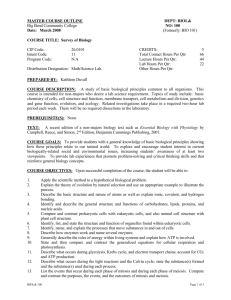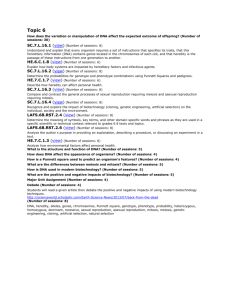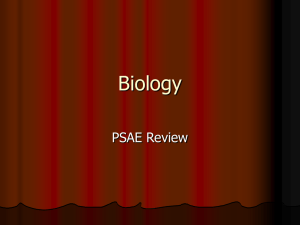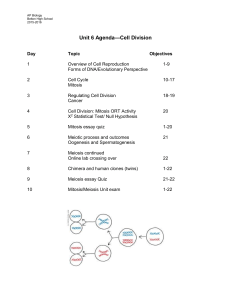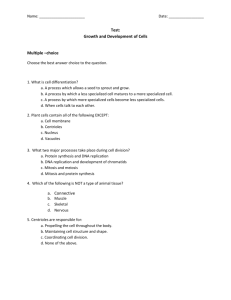Year 11 – Human Biology – Course Outline
advertisement
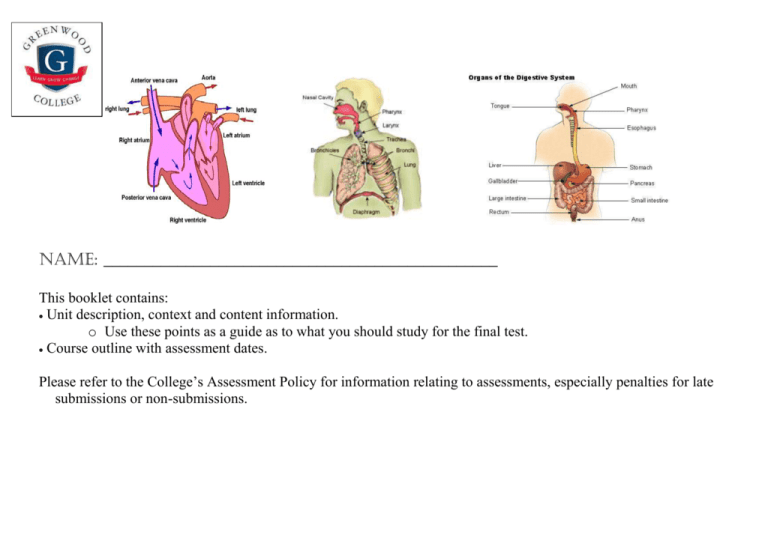
Name: ________________________________________________ This booklet contains: Unit description, context and content information. o Use these points as a guide as to what you should study for the final test. Course outline with assessment dates. Please refer to the College’s Assessment Policy for information relating to assessments, especially penalties for late submissions or non-submissions. Greenwood College Human Biology ATAR course Unit 1 and 2 Program 2015 TEACHER: Mr J Weber Resource Key: HP = Human Perspectives ATAR Units 1 & 2 Week 1 Overall Content Introduction to course. Science Inquiry Skills HP 4th ed. = Human Perspectives 4th ed. In class old text. Content Focus Introduce course/assessment outlines. Use syllabus as a checklist. Brainstorm “What is Human Biol?” HB is the study of humans, both as individuals and popns and their interaction with the environment. Brainstorm “What is Science?” systematic observation & Resources/Activities testing of ideas = experiments See Table 1.1 pg 5 HP Briefly discuss “How do scientist investigate?” pg 5 HP Revise Scientific Method and common terms. “How do scientist avoid bias and error?” pg 7 HP 2 3 Cells Cells and methods of transport. Cell – Structures and functions Revise safe microscope use and parts. Learn how to use minigrid via RTG ELMO. Use microscopes/micrographs to explore organelle structures involved in metabolism. SA/VOL ratio & conc. gradients effect on rate of movement. “Level’s of organization”. Explain “Cell Theory”, read HP pg 28 1st para only. Homeostasis Structure of the cell membrane Explain & demonstrate diffusion (via food dye) and osmosis (via Gummy Bears) Homework / Assessments Review Q’s 5,7 & 8 pg 13. Apply Your Knowledge (AYK) 5&6 pg 13 Investigation terms – p/point. ‘Scientific Method” w/sheet. “Experimental Design” Pairs Check w/sheet Dictogloss HP pg 7. HP Chapter 3 Cell parts/functions Silent Card Shuffle Cell colouring Microscope revision w/sheet Pairs check MS calcs Lab exercise – Observing cells, activity 3.1 – p35 Read “Why are cells so small?” HP text, pg 33. Why are cells so small? w/sheet HP2 Chapter 4 Read “Cell requirements” pg 40. Answer RQ’s 1-2 pg 39 Transport p/point. Cell membrane – Border security w/sheet. Cut n Paste Concept map w/sheet Task 1: Second hand data test H/work q’s. 1. Why does a small piece of apple have a larger surface area than a whole apple? 2. Why can a small cell support itself better than a large cell? Week 3 ISSUE Task 2. Cell Study 4 Tissue types. Metabolism Methods of transporting material across membrane Demo osmosis via deshelled eggs. Tissues perform specific functions and can be categorised into four basic groups: epithelial, connective, muscular and nervous. 5 Enzymes 6/7 Circulatory System Define metabolism, anabolism, catabolism with e.g. of reactions. Cellular respiration occurs in different locations, with/out O2 to release energy, which can be stored as ATP. Nutrients required and their uses. Define metabolism, anabolism, catabolism with e.g. of reactions. Identify structure, function and factors effecting enzymes in the body Lab on enzymes. Introduction to circulatory system — components and their roles/function. Ask the class, “What is the role of the heart?” Roles of plasma & erythrocytes in the transport of materials including oxygen, nutrients & wastes. Blood — components cellular and non-cellular. Role of the heart, arteries, veins and capillaries in the circulation of blood. STAWA Act 9(lab) What do we accurately measure volume a liquid with? Explain difference between measuring cylinder and beaker. Answer WACE exam 2013 question 36 HP Chapter 5 Tissue p/point. Homework: HP RQ’s 2 – 5, pg 61 HP Chapter 6 “Cells perform…growth” h/out “Cellular respiration –gives u wings” w/sheet. “What kind of chemical changes” w/sheet. Food glorious food w/sheet. Refer to HP 4th ed. HP Chapter 6 Show/discuss power point on Enzymes. “Enzymes” dictogloss. Complete “Enzymes” w/sheet. Cut n Paste Concept map w/sheet. STAWA Act 27 (lab) HP Chapter 7 “Have a heart” w/sheet. “The circulatory system” colour-in. Cardiac circulation revision: “Which way does the blood go?” w/sheet. Heart dissection? STAWA Act 14 – Part B ONLY (lab) “The role of erythrocytes (Red Blood Cells) and Plasma in the transport of O2 & CO2” w/sheet. Present Task 2, cell Study. Task 3: Cells & Metabolism Test. Show “Unit 2A Blood” p/point. Students listen for specific answers, then jigsaw. 6/7 7/8 Circulatory System Term 2 Week 1 1/2 Clotting of blood at wound and inflammatory response. Lymphatic, drainage and defence. ABO blood group system – antigens, antibodies, universal donors and receivers. Rh & Transfusions. HP Chapter 8 “Have a heart” w/sheet, Side A. Unit 2A Blood p/point Digestive system Digestive system parts. Mechanical digestion, peristalsis and elimination. Absorption via capillaries and lymph vessels. Healthy eating and eating disorders. Excretory System Intro and deamination of a.a. in the liver Formation of urine and excretion. Excretory System STAWA Act 13 The nephron Revision = Inside/outside circle Q’s: digestion, excretion HP pg 95. RQ 7 “Have a heart” w/sheet, Side B. Clotting of blood and Inflammatory Response power point questions. Lymphatic System w/sheet. “What blood type can donate to me?” info sheet. HP pg 95. RQ’s 10, 11, 12b, 13, 14. Colouring in resp system Introduce respiratory system — structures/functions. “Gas exchange” pics h/out. Gas exchange including characteristics of respiratory “Gas exchange and surfaces. maintenance..” w/sheet Maintenance of concentration gradients in lungs Demo – Bell Jar including breathing and blood flow. STAWA Act 12 Effects of lifestyle & environment on gas exchange. Respiratory System 8/9 Cardiac Cycle Colouring in w/sheet. “It’s alimentary my dear Watson.” w/sheet “Are you absorbing all this info?” w/sheet. STAWA Act 22, Part A and B only. HP Chapter 10 STAWA Activity 20 Homeostatic control of fluids w/sheet “You have got to be kidney.” “The nephron” wsheet HP pg 106. RQ 1,3,4,7 and 8. Task 4 Respiration & Circulation Test “Urine formation q’s” w/sheet 1/2 Skeleton Skeleton—structure and function related to: 3/4 Muscles 5 6/7 EXAMS DNA 8/9 Mitosis and Cancer 10/11 Body Systems Reproductive Macro & microscopic structure of bone Cartilage types – Hyaline, Elastic & Fibrocartilage. Structure & function of major joint types Including ball & socket, hinge, pivot, gliding, immovable. Types of movement Effects of ageing on the skeletal system. Muscles—structure & function related to: Macroscopic including the types, locations & resulting movements Microscopic including myofibrils Molecular including actin, myosin Antagonistic Muscles – sliding filament theory. EXAMS EXAMS Structure of DNA - helix, complimentary bases, histones, template & coding strands. DNA replication Functions of Proteins - why do we need them? Protein Synthesis - transcription, translation, mRNA production, amino acid sequencing. Epigenetics - factors controlling protein synthesis Mitosis Revise replication Cancer Male reproductive system - structure & function. Female reproductive system - structure & function. Revise mitosis Meiosis Crossing over, non-disjunction, random assortment. HP Chapter 12 Skeleton Bingo HP Chapter 11 Week 3 Task 5 Digestion and excretion test. Week 4 ASSIGNMENT FREE WEEK. HP Chapter 13 DNA structure w/sheet DNA – Code for life w/sheet. KNEX model building? Transcription translation w/sheet You tube clip showing transcript/latn in REAL TIME. HP Chapter 14 Mitosis p/point. Silent Card Shuffle. 1 metre rulers model. HP Ch 14 RQ’s 8-10 pg 190 Colour and label male/female w/sheets. Mitosis/meiosis p/point 1 metre rulers model. Silent card shuffle H/work Cut n Paste AND Find, use and demonstrate “Mitosis” app from “I-tunes” or “Google play store”. Answer RQ 1 pg 63. Copy down Q: “Why it is vital each new cell receives the exact same amount of DNA?” Answer: see HP pg 184. The genetic information is passed on… Week 11 Task 6 DNA, mitosis, meiosis and reproductive parts test. Term 3 1 Meiosis 2 3 Body Systems Reproductive Body Systems Reproductive 4 Body Systems Reproductive 5 Body Systems Reproductive 6 Body Systems Reproductive Ovarian and Menstrual cycles. Hormone regulation - pituitary, hormones, blood & target organ, hormones - table 16.2 pg 214. Conception - sexual intercourse, fertilisation, egg & sperm - zygote - embryo -morula - blastocyst foetus. Embryonic development, embryo -morula - blastocyst - implantation - foetus. Primary Germ Layers - ectoderm, mesoderm, endoderm. Embryonic membranes - amnion, chorion, allantois, yoke sac. Development of the placenta. Revise Stem Cells 223/224 Sources/ ethics/research/therapy and legislation. Foetal development (overview only). Pregnancy changes to the mother. Maintaining a healthy pregnancy - diet, smoking & alcohol, chemicals. Disruptions to foetus - congenital disorders, teratogens, infections, viruses. Diagnosis of foetal health - ultrasound, fetoscopy, Foetal blood sampling, Foetal monitoring. amniocentesis & CVS. Treatments of Infertility - AID, IVF, ART, GIFT, ICSI donors & surrogacy. 3 Stages of Labour - main events & timeframe. Changes to baby at birth - circulation. Changes to mother after birth. Structure & function of breast. Lactation - milk let down reflex. Differences between mitosis & meiosis Variations in genotypes due to meiosis and fertilisation Spermatogenesis / oogenesis Spemato/oogenesis w/sheet Ovarian/menstrual cycle p/point Tale of the menstrual cycle w/sheet Hormonal control of spermat/oogenesis w/sheet Let it flow w/sheet STAWA Act 44 OMG! Implantation w/sheet Cell differentiation p/point “Development of the embryo” p/point for pics. “Stem cells..” w/sheet. Changes to baby/mother w/sheet Prenatal care questions. Prenatal care questions, complete Q 10, summary table. Treatment of infertility PMI chart. From fertilisation to birth timeline w/sheet. “Birth” w/sheet Breast structure and feeding w/sheet. H/work Cut n Paste OR Find, use and demonstrate “Mitosis” app from “Itunes” or “Google play store”. Human model with 1 metre rulers. Pictorial pop quiz p/point Task 7 Ovarian / Menstrual cycles, Primary Germ Layers, 7 8/9 Life Choices & STI's Genetics DNA Physical development in infancy (overview only) Diagnosis of foetal health TEST. Methods of contraception - barrier/chemical/short term/ permanent. Related ethical issues Diseases transmitted through unprotected sex or genital contact - symptoms & treatments. Prevention Revise DNA - gene, loci, allele. Introduce Gregory Mendel - pea studies. Monohybrid crosses - probable frequencies of genotype and phenotype, punnet squares. Recessive, dominance, codominance, autosomal & sex-linked. Diseases - PKU, Huntington's, colourblind, haemophilia. ABO blood inheritance - antigens & antibodies. Inheritance patterns & eg diseases. Pedigree charts - symbols/construction & use to determine inheritance pattern - eg diseases. ISSUE Task 3 STI’S/Contraception research asst. 10/ Term 4 Week 1 Genetics Inheritance 2 Human Variation 3/4 Human Variation 5 6 Science Inquiry Skills Genetic counselling - options. DNA profiling - electrophoresis DNA fingerprinting. Ethical issues of profiling - health insurance issues Variation - eg's, skin colour/ height, body morphology. Revise meiosis. Creating genetic diversity through: Random assortment, random fertilisation, crossing over, nondisconjunction, epigenetics. Non-disconjunction - Trisomy, Monosomy, Down syndrome, Turner syndrome Revise experimental design. STUDY TECHNIQUES. EXAMS EXAMS EXAMS Mendelian inheritance p/point. Genetics w/sheets. Revise “which blood type can donate to me” chart. Pedigree chart w/sheet package. Other modes of inheritance p/point. Multiple alleles/polygenic inheritance w/sheet Human variation p/point. Task 8 STI’s & contraception research assignment / validation test. Task 9 Genetics and Inheritance Test. Task 10 2nd hand data test Assessment Outline. SCASA weighting 20% Greenwood College weighting Type 20% Science inquiry Science inquiry involves identifying and posing questions; planning, conducting and reflecting on investigations; processing, analysing and interpreting data; and communicating findings. It is concerned with evaluating claims, investigating ideas, solving problems, reasoning, drawing valid conclusions, and/or developing evidence‐based arguments. 15% 15% Extended Response Tasks requiring an extended response can involve selecting and integrating appropriate science concepts, models and theories to explain and predict phenomena, and applying those concepts, models and theories to new situations; interpreting scientific and/or media texts and evaluating processes, claims and conclusions by considering the quality of available evidence; and using reasoning to construct scientific arguments. Task Task Weighting Task 1: Second Hand Data Test. Students demonstrate their understanding of the planning, analysing and evaluating phases of an experiment. 10% Task 10: Second Hand Data Test. Students demonstrate their understanding of the planning, analysing and evaluating phases of an experiment. 10% Task 2: Cell study 7.5% Approximate Due date Term 1 Week 2 Term 4 Week 5 Term 1 Week 5 Students research different methods of membrane transport and design and conduct own experiments to demonstrate understanding. Task 8: STD’s and contraception. Students research the physiological and social effects of STD’s and contraception, then complete a validation test. 7.5% Term 3 Week 8 25% 25% Test Tests typically consist of multiple choice questions and questions requiring short and extended answers. They should be designed so that students can apply their understanding and skills in human biology to analyse, interpret, solve problems and construct scientific arguments. Task 3: Cells and metabolism. 3.5% Term 1 Week 3 Task 4: Respiratory and circulation. 3.5% Term 1 Week 8 3.5% Term 2 Week 3 3.5% Term 2 Week 11 3.5% Term 3 Week 6 4% Term 4 Week 4 Task 5: Digestion and excretion Task 6: DNA, mitosis, meiosis and reproductive parts. Task 7: Ovarian/menstrual cycle, Primary germ layers, diagnosis of foetal health. Task 9: Genetics and inheritance. 40% 40% Examination Typically conducted at the end of each semester and/or unit. In preparation for Unit 3 and Unit 4, the examination should reflect the examination design brief included in the ATAR Year 12 syllabus for this course. Task 11: Homework completion. 3.5% N/A Semester 1 examinationUnit 1. 20% Term 2 Week 5 Semester 2 examinationUnit 1 and 2. 20% Term 4 Week 6 Unit content – Your check list for what you need to know. Science Inquiry Skills identify, research and construct questions for investigation; propose hypotheses; and predict possible outcomes. design investigations, including the procedure(s) to be followed, the materials required, and the type and amount of primary and/or secondary data to be collected; conduct risk assessments; and consider research ethics, including animal ethics. conduct investigations, including monitoring body functions; use microscopy techniques; and perform real or virtual dissection, safely, competently and methodically for the collection of valid and reliable data. represent data in meaningful and useful ways; organise and analyse data to identify trends, patterns and relationships; qualitatively describe sources of measurement error, and uncertainty and limitations in data; and select, synthesise and use evidence to make and justify conclusions. interpret a range of scientific and media texts, and evaluate processes, claims and conclusions by considering the quality of available evidence; and use reasoning to construct scientific arguments. select, construct and use appropriate representations, including labelled diagrams and images of various cells, tissues and organ systems, to communicate conceptual understanding, solve problems and make predictions. communicate to specific audiences, and for specific purposes, using appropriate language, nomenclature, genres and modes, including scientific reports. Science as a Human Endeavour blood transfusions rely on determining blood groups and can be used to treat many different diseases and conditions. treatment of conditions due to system or organ dysfunction has changed through improvements in early diagnosis and appropriate use of drugs, physical therapy, radiation therapy, and removal and/or replacement of affected parts. osteoporosis and osteoarthritis are diseases, primarily of ageing, that cause disability. Increased understanding of the causes of these conditions leads to improved practices for management and prevention. lifestyle choices, including being active or sedentary, the use of drugs and type of diet, can compromise body functioning in the short term and may have long‐ term consequences. Science Understanding Cells and tissues the human body is comprised of cells, tissues and organs within complex systems that work together to maintain life. cell organelles maintain life processes and require the input of materials and the removal of wastes to support efficient functioning of the cell. the cell membrane separates the cell from its surroundings with a structure, described by the fluid mosaic model, which allows for the movement of materials into and out of the cell by diffusion, facilitated diffusion, osmosis, active transport and vesicular transport (endocytosis/exocytosis) factors affecting the exchange of materials across the cell membrane include surface area to volume ratio, concentration gradients, and the physical and chemical nature of the materials being exchanged. the various tissues of the human body perform specific functions and can be categorised into four basic tissue types: epithelial, connective, muscular and nervous Metabolism biochemical processes, including anabolic and catabolic reactions in the cell, are controlled in the presence of specific enzymes. cellular respiration occurs, in different locations in the cytosol and mitochondria, to catabolise organic compounds, aerobically or anaerobically, to release energy in the form of adenosine triphosphate (ATP). for efficient metabolism, cells require oxygen and nutrients, including carbohydrates, proteins, lipids, vitamins and minerals enzyme function can be affected by factors including pH, temperature, presence of inhibitors, co‐enzymes and co‐factors, and the concentration of reactants and products. Respiratory system the exchange of gases between the internal and external environments of the body is facilitated by the structure and function of the respiratory system at the cell, tissue and organ levels. the efficient exchange of gases in the lungs is maintained by the actions of breathing, blood flow and the structure of the alveoli. Circulatory system the transport of materials within the internal environment for exchange with cells is facilitated by the structure and function of the circulatory system at the cell, tissue and organ levels. the components of blood facilitate the transport of different materials around the body (plasma and erythrocytes), play a role in the clotting of blood (platelets) and the protection of the body (leucocytes). the lymphatic system functions to return tissue fluid to the circulatory system and to assist in protecting the body from disease. Digestive system the supply of nutrients in a form that can be used in cells is facilitated by the structure and function of the digestive system at the cell, tissue and organ levels digestion involves the breakdown of large molecules to smaller ones by mechanical digestion (teeth, bile and peristalsis) and chemical digestion (by enzymes with distinctive operating conditions and functions that are located in different sections of the digestive system). the salivary glands, pancreas, liver and gall bladder produce or store secretions which aid the processes of digestion. absorption requires nutrients to be in a form that can cross cell membranes into the blood or lymph and occurs at different locations, including the small intestine and large intestine. elimination removes undigested materials and some metabolic wastes from the body. Musculoskeletal system the muscular system is organised to maintain posture and produce movement; muscle fibre contraction can be explained using the sliding filament theory. movement results from the actions of paired muscles, with others acting as stabilisers, to produce the required movement. the skeletal framework of the body consist of bone and cartilage which function to provide body support, protection and movement, and is facilitated by the structure and function at cell and tissue levels. articulations of joints of the skeleton are classified according to their structure or the range of movements permitted. Excretory system the excretory system regulates the chemical composition of body fluids by removing metabolic wastes and retaining the proper amounts of water, salts, and nutrients; components of this system include the kidneys, liver, lungs, and skin functioning at the organ level. deamination of amino acids in the liver produces urea, which then is transported to the kidneys for removal. the nephrons in the kidney facilitate three basic processes: filtration, reabsorption and secretion during urine formation to maintain the composition of body fluids (hormone control is not required). Semester 2. Unit 2 – Reproduction and inheritance Science Inquiry Skills As above and including the following. select, construct and use appropriate representations, including models of DNA replication, transcription and translation, Punnett squares, pedigrees and karyotypes, to communicate conceptual understanding, solve problems and make predictions. Science as a Human Endeavour the use of genetic profiling and genetic screening of adults and embryos have implicit ethical considerations. discoveries made through the use of modern biotechnological techniques have increased understanding of DNA and gene expression. greater understanding of the menstrual cycle, conception and implantation has produced improved methods of the establishment of a pregnancy, along with advancements in contraceptive methods; both have ethical considerations. new technologies, including Pap smear, breast screening and blood tests for prostate cancer, have made early detection of cancers possible lifestyle choices, including diet, illicit drugs, alcohol and nicotine, may affect foetal development. Science Understanding DNA DNA occurs bound to proteins in chromosomes in the nucleus and as unbound DNA in the mitochondria. DNA stores the information for the production of proteins that determines the structure and function of cells. the structural properties of the helical DNA molecule, including double‐stranded, nucleotide composition and weak bonds involved in base pairing between the complementary strands, allow for its replication. protein synthesis involves the transcription of a gene on DNA into messenger ribonucleic acid (RNA) in the nucleus, and translation into an amino acid sequence at the ribosome with the aid of transfer RNA. epigenetics is the study of phenotypic expression of genes, which depends on the factors controlling transcription and translation during protein synthesis, the products of other genes, and the environment. Cell reproduction mitosis forms part of the cell cycle producing new cells with the same genetic content. the sequence of DNA replication, chromosome duplication and chromosome separation are important processes in the production of identical daughter cells by mitosis for growth, repair and replacement of tissues within the body. stem cells have the ability to divide by mitosis and differentiate into many different tissues, depending on the level of cell potency. uncontrolled division of cells can result in the development of tumours/cancers. meiosis produces gametes for reproduction and involves DNA replication, chromosome pairing, and two successive nuclear divisions distributing haploid sets of chromosomes to each gamete. crossing over, non‐disjunction and random assortment of chromosomes during meiosis will produce gametes with different genetic content. differences between mitosis and meiosis reflect their roles in the body. variations in the genotypes of offspring, including gender, arise as a result of the processes of meiosis and fertilisation. Human reproduction the production of offspring is facilitated by the structure and function of the male and female reproductive systems in producing and delivering gametes for fertilisation and providing for the developing embryo and foetus. both male and female reproductive systems are regulated by hormones, including the regulation of the menstrual and ovarian cycles. human gametes are produced through spermatogenesis and oogenesis, which are specific forms of meiosis, but varying significantly in process and products for the establishment of a pregnancy, conception requires the union of viable sperm and ovum at the optimal time in the ovarian cycle. the development of the embryo after implantation involves the differentiation of cells into three different germ layers that will eventually produce specific systems in the body and the placenta. the stages of labour include birth, during which there are circulatory system changes in the child. contraception methods that reduce the probability of the union of gametes or implantation all have limitations, risks and benefits, and include methods that: use steroid hormones use physical barriers between gametes use chemical spermicides use sterilisation (tubal ligation, vasectomy) function after coitus (emergency contraceptive pill and intrauterine devices [IUDs]). Sexually transmitted infections (STIs), diseases transmitted through unprotected sex or genital contact, can be prevented through safe sex methods; early detection and treatment of infection are important and, if left untreated, STIs can lead to serious health consequences. there are a variety of assisted reproductive technologies to help overcome infertility problems, but each has its limitations, risks and benefits. there are a range of techniques available to genetically screen embryos before implantation or during early development, including blood tests, amniocentesis and chorionic villi sampling. Types of inheritance probable frequencies of genotype and phenotype of offspring can be predicted using Punnett squares and by taking into consideration patterns of inheritance, including the effects of dominance, co‐dominance, autosomal or sex‐linked alleles, and multiple alleles: Huntington's disease, phenylketonuria (PKU), ABO blood groups, red–green colour blindness/haemophilia show different inheritance patterns. pedigree charts can be constructed for families with a particular genetic disorder and can be used to reveal patterns of inheritance and assist in determining the probability of inheriting the condition in future generations. DNA profiling identifies the unique genetic make‐up of individuals and can be used in determining parentage.


